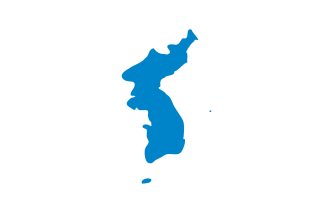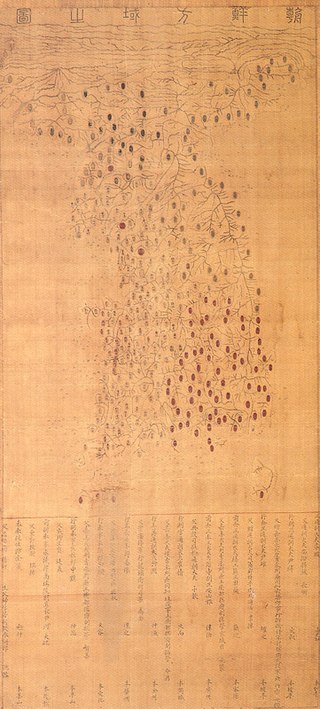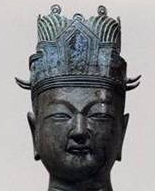Related Research Articles

Korea is a peninsular region in East Asia. Since 1945, it has been divided at or near the 38th parallel, now known as the Korean Demilitarized Zone, with South Korea comprising its southern half and North Korea comprising its northern half. The region consists of the Korean Peninsula, Jeju Island, and a number of minor islands near the peninsula. The peninsula is bordered by China (Manchuria) to the north and Russia to the northeast, across the Amnok and Duman rivers. It is separated from Japan to the southeast by the Korea Strait.

The Lower Paleolithic era on the Korean Peninsula and in Manchuria began roughly half a million years ago. The earliest known Korean pottery dates to around 8000 BC, and the Neolithic period began after 6000 BC, followed by the Bronze Age by 2000 BC, and the Iron Age around 700 BC.

Balhae, also rendered as Bohai, was a multi-ethnic kingdom established in 698 by Dae Joyeong and originally known as the Kingdom of Jin until 713 when its name was changed to Balhae. At its greatest extent it corresponded to what is today Northeast China, the northern half of the Korean Peninsula and the southeastern Russian Far East.

Goryeo was a Korean state founded in 918, during a time of national division called the Later Three Kingdoms period, that unified and ruled the Korean Peninsula until 1392. Goryeo achieved what has been called a "true national unification" by Korean historians as it not only unified the Later Three Kingdoms but also incorporated much of the ruling class of the northern kingdom of Balhae, who had origins in Goguryeo of the earlier Three Kingdoms of Korea. The name "Korea" is derived from the name of Goryeo, also romanized as Koryŏ, which was first used in the early 5th century by Goguryeo. According to Korean historians, it was during the Goryeo period that the individual identities of Goguryeo, Baekje and Silla were successfully merged into a single entity that became the basis of the modern-day Korean identity. Goryeo was the successor state to Later Goguryeo and Goguryeo.
Korean monarchy existed in Korea until the end of the Japanese occupation and the defeat of Japan. After the independence and the installation of the Constitution that adopted republic system, the concept of nobility has been abolished, both formally and in practice.

Samguk yusa or Memorabilia of the Three Kingdoms is a collection of legends, folktales and historical accounts relating to the Three Kingdoms of Korea, as well as to other periods and states before, during and after the Three Kingdoms period. "Samguk yusa is a historical record compiled by the Buddhist monk Il-yeon in 1281 in the late Goryeo Dynasty." It is the earliest extant record of the Dangun legend, which records the founding of Gojoseon as the first Korean nation. The Samguk yusa is National Treasure No. 306.
Seongjong of Goryeo (r. 981–997) was the sixth ruler of the medieval Korean kingdom of Goryeo.

The hanbok is a traditional clothing of the Korean people. The term hanbok is primarily used by South Koreans; North Koreans refer to the clothes as chosŏn-ot (조선옷).

Korea's military history spans thousands of years, beginning with the ancient nation of Gojoseon and continuing into the present day with the countries of North Korea and South Korea, and is notable for its many successful triumphs over invaders. Throughout its history, Korea has boasted numerous exceptional leaders who gained outstanding victories against numerically superior enemies. Famed leaders credited with defending Korea against foreign invasions include: Eulji Mundeok of Goguryeo, who defeated Sui China during the Goguryeo–Sui War; Yeon Gaesomun of Goguryeo, who defeated Emperor Taizong of Tang China during the Goguryeo–Tang War; Gang Gam-chan of Goryeo, who defeated the Khitan Empire during the Goryeo-Khitan War; Choe Yeong and Yi Seong-gye of Goryeo, who defeated the Red Turbans during the Red Turban Invasions; and Yi Sun-shin of Joseon, who defeated the Japanese at sea during the Imjin War. Other notable leaders include: Gwanggaeto the Great of Goguryeo, who created a great empire in Northeast Asia through conquest, and subjugated the other Korean kingdoms of Baekje, Silla and Gaya to bring about a brief unification of the Three Kingdoms of Korea; Geunchogo of Baekje, who captured Pyongyang and established overseas territories to control much of the Korean peninsula and dominate the seas; Munmu and Kim Yu-sin of Silla, who united the Three Kingdoms of Korea and defeated Tang China to gain complete control of the Korean peninsula; Dae Jo-yeong, who created Balhae from Goguryeo's ashes and reconquered Goguryeo lands lost during the Goguryeo-Tang War; Jang Bogo of Later Silla, who created a maritime empire and commanded a powerful fleet; Wang Geon, who united the Later Three Kingdoms of Korea and established Goryeo as the successor to Goguryeo; and Yun Gwan of Goryeo, who defeated the Jurchens and constructed nine fortresses in Manchuria.

Taejo of Goryeo, also known as Taejo Wang Kŏn, was the founder of the Goryeo dynasty, which ruled Korea from the 10th to the 14th century. Taejo ruled from 918 to 943, achieving unification of the Later Three Kingdoms in 936.

The Dongguk Tonggam is a chronicle of the early history of Korea compiled by Seo Geo-jeong (서거정) (1420–1488) and other scholars in the 15th century. Originally commissioned by King Sejo in 1446, it was completed under the reign of Seongjong of Joseon, in 1485. The official Choe Bu was one of the scholars who helped compile and edit the work. The earlier works on which it may have been based have not survived. The Dongguk Tonggam is the earliest extant record to list the names of the rulers of Gojoseon after Dangun.

This is a timeline of the history of Korea. Some dates prior to the 5th century are speculative or approximate. For era names see Era names in Korean history.

The Northern and Southern States period is the period in Korean history when Unified Silla and Balhae coexisted in the south and north of the peninsula, respectively.
The Goguryeo controversies are disputes between China and Korea on the history of Goguryeo, an ancient kingdom located in present-day Northeast China and the Korean Peninsula. At the heart of the Goguryeo controversy is which part of history the kingdom belongs to. Korean scholars have the viewpoint that Goguryeo is part of Korean history alone.

Gwanbok is a Korean term which was borrowed from the Chinese terms guanfu and guanfu. The term gwanbok is a collective term which refers to historical official attire, which was bestowed by the government court, including Chinese courts of various dynasties. The guanfu (冠服) system was a court attire system in China which also formed part of the Hanfu system. This system was them spread to neighbouring countries and was adopted in Korea since ancient times in different periods through the ritual practice of bestowal of clothing. Acknowledgement through bestowed robes and crowns (冠服) from the Emperor of China, who held hegemony over East Asia, would give support to Korean Kings and successors, as being the authentic rulers of their country as well as confirmed the political status of the Korean kingdom in the rest of the Sinosphere. The gwanbok system in Korea was different for each kingdom and changed throughout different periods. For example, initially given by the Chinese court in ritual practice, successive gwanbok were more often than not locally manufactured in Korea with different colours and adopted into hanbok. The gwanbok, which was used as the uniform of court officials, formed part of the gwanbok system and was used like the suit is nowadays.

The history of Sino-Korean relations dates back to prehistoric times.

Korean nationalist historiography is a way of writing Korean history that centers on the Korean minjok, an ethnically defined Korean nation. This kind of nationalist historiography emerged in the early twentieth century among Korean intellectuals who wanted to foster national consciousness to achieve Korean independence from Japanese domination. Its first proponent was journalist and independence activist Shin Chaeho (1880–1936). In his polemical New Reading of History, which was published in 1908 three years after Korea became a Japanese protectorate, Shin proclaimed that Korean history was the history of the Korean minjok, a distinct race descended from the god Dangun that had once controlled not only the Korean peninsula but also large parts of Manchuria. Nationalist historians made expansive claims to the territory of these ancient Korean kingdoms, by which the present state of the minjok was to be judged.
Chinese influence on Korean culture can be traced back as early as the Goguryeo period; these influences can be demonstrated in the Goguryeo tomb mural paintings. Throughout its history, Korea has been greatly influenced by Chinese culture, borrowing the written language, arts, religions, and models of government administration from China, and, in the process, transforming these borrowed traditions into distinctly Korean forms.
Imperial titles were used in various historical Korean states before the 14th century and at the turn of the 20th century: Early Korean states used "great king", "greatest king", and "holy king"; later Korean states used "emperor". Korean monarchs who used imperial titles had political and religious authority over a realm or domain. The Chinese concept of tianxia, pronounced "cheonha" in Korean, was variously adopted and adapted to Korean views of the world from period to period.
The Balhae controversies involve disputes between China, Korea, Japan, and Russia, countries that have conducted studies on the historical state of Balhae. The Korean perspective generally considers Balhae to be the successor state of Goguryeo and part of the Northern and Southern States period of Korean history, while Chinese scholars generally consider Balhae to be a state of the Mohe people, a Tungusic ethnic group, and subordinate to the Tang dynasty (618––907). In Russian historiography, Balhae is recognized as the first highly-organized independent state formation of the Tungus-Manchurian peoples.